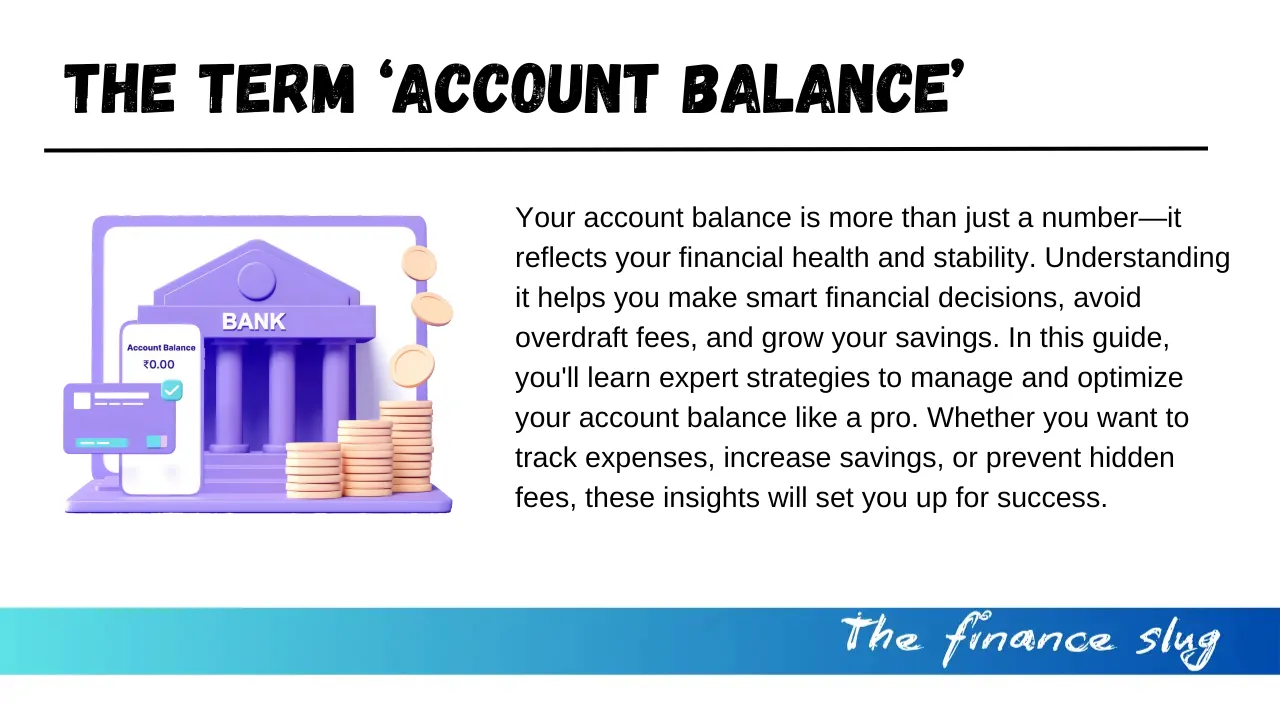
Your account balance is more than just a number—it reflects your financial health and stability. Understanding it helps you make smart financial decisions, avoid overdraft fees, and grow your savings. In this guide, you’ll learn expert strategies to manage and optimize your finances. Whether you want to track expenses, increase savings, or prevent hidden fees, these insights will set you up for success.
Understanding Your Account Balance Like a Pro
Your account balance represents the total money available in your financial account at any time. It includes deposits, withdrawals, and pending transactions. Unlike most generic guides, this article provides expert insights and lesser-known strategies to help you optimize your finances.
Why Monitoring Your Balance Matters
Many people overlook the importance of tracking their available funds until they face financial issues. Here’s why staying on top of it is essential:
- Prevents overdraft fees and unnecessary charges
- Helps you make informed spending decisions
- Ensures financial security and preparedness
- Aids in wealth-building and long-term planning
Little-Known Factors That Affect Your Balance
Most blogs only cover basic concepts, but here are some unique factors that influence your available funds:
1. Timing of Transactions
Many banks process transactions at specific times of the day. If you make a deposit late, it may not reflect until the next business day.
2. Bank Processing Delays
Some banks take longer to update balances, especially for checks and external transfers.
3. Subscription & Auto-Payment Traps
Many people forget about small automatic payments, which can significantly impact their financial stability over time.
4. Real vs. Available Funds
Your bank might show a higher balance due to pending transactions that haven’t cleared yet.
Also read: Accidental Death Benefits: Essential Protection Your Family Needs Now
Unique Strategies to Manage Your Balance Effectively
Instead of common budgeting tips, try these unique approaches:
1. Implement a Daily Money Check-In
Dedicate just five minutes each morning to reviewing your finances and upcoming transactions.
2. Use the 70/20/10 Rule
Allocate your income wisely:
- 70% for essential expenses
- 20% for savings
- 10% for discretionary spending
3. Turn Unexpected Cash into Financial Boosters
Whenever you receive a tax refund, bonus, or gift money, put a percentage of it into your savings instead of spending it immediately.
4. Automate Smart Transfers
Set up automated transfers so that your funds grow steadily without requiring manual action.
Avoiding Costly Mistakes That Hurt Your Balance
1. Ignoring Small Transactions
Multiple small purchases can add up, leading to a lower-than-expected balance.
2. Over-Reliance on Credit Cards
Keeping a healthy financial reserve prevents unnecessary credit card debt.
3. Not Reviewing Bank Fees
Many banks charge hidden fees that reduce your funds over time. Always check your statement for unusual charges.
Also read: Will Shiba Inu Coin Reach $1 in 2025? Huge Profit Potential
How to Grow Your Balance Consistently
1. Build Passive Income Streams
Find ways to earn extra money, such as investing in dividend stocks, starting a side hustle, or renting out unused assets.
2. Set Incremental Savings Goals
Instead of setting one large goal, break it down into smaller, achievable milestones to maintain motivation.
3. Leverage High-Yield Savings Accounts
Moving your funds into high-interest accounts can help them grow faster.
Final Takeaway: Stay in Control of Your Finances
Your available funds are more than just a number—they’re a key indicator of your financial health. By applying these unique strategies, you can build long-term financial stability, avoid unnecessary fees, and maintain a growing reserve effortlessly. Take charge today and make smarter financial decisions for a secure future!
FAQs
1. Why is it important to check my account balance regularly?
Regularly checking your account balance helps prevent overdraft fees, track spending, and ensure financial stability.
2. What’s the difference between available balance and current balance?
The available balance reflects funds you can use, while the current balance includes pending transactions that haven’t cleared yet.
3. How can I increase my account balance?
You can grow your account balance by budgeting wisely, saving consistently, automating transfers, and using high-yield savings accounts.
4. How do bank fees affect my account balance?
Hidden bank fees, such as maintenance charges and overdraft fees, can reduce your account balance over time, so always review your statements.
Stock Market Crash Today: A Bloodbath on Monday – What You Need to Know
Published on financeslug.xyz The global financial markets are reeling from a massive sell-off, and Indian…
Wall Street Bonuses Reach Record $47.5 Billion in 2024, Up 34% from Previous Year
How to Convert Delimited CSV Data into Columns in Excel
CSV (Comma-Separated Values) files are widely used for data exchange, but when opened in Excel,…
Harvard University Announces Free Tuition for Families Earning $200K or Less
Harvard’s New Tuition-Free Policy: What You Need to Know Harvard University has unveiled a groundbreaking…
Eli Lilly’s 1.8B Dollar Investment in Weight Loss Drugs
Ireland’s Weight-Loss Drug Boom: A Game-Changer for Economy and Healthcare Ireland is witnessing a surge…
Forever 21 Files for Bankruptcy Again: The End of an Era in Fast Fashion?
Forever 21, once a staple in American malls and a leader in the fast-fashion industry,…







